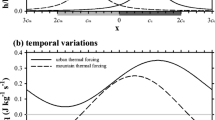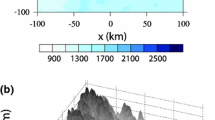Abstract
A large number of cities around the world are located in or near complex terrain. In these regions, urban breeze circulation and mountain/valley winds are observed. Understanding interactions between urban breeze circulation and mountain/valley winds is important in a view of mesoscale atmospheric dynamics and urban air pollution. In this study, we theoretically examine the interactions of urban breeze circulation with mountain slope winds in the context of the response of the atmosphere to specified thermal forcing. Starting from linearized governing equations in two dimensions, analytical solutions for perturbation vertical velocity, horizontal velocity, buoyancy, and kinematic pressure are obtained. Then, the analytical solutions are used to examine the interactions. Urban breeze circulation and mountain slope winds evolve with time due to time-varying thermal forcing that has steady and diurnal components, and they interact with each other. Asymmetric flows are developed over the urban and mountain areas. In the daytime, low-level converging flows induced by urban heating (urban breeze) and those induced by mountain heating (upslope winds) interfere with each other, resulting in weakened flows in the mountain-side urban area and on the urban-side mountain slope. The transition from the upslope wind to downslope wind on the urban-side mountain slope occurs earlier and thus the downslope wind persists longer compared with the case that has mountain thermal forcing only. In the nighttime, flows become strong in the region between the urban center and the mountain center due to the additive interaction of the downslope wind with the urban breeze, but the flow intensity weakens with time because of weak nighttime urban heating. In the nighttime, converging flows on the plain-side urban area and the downslope wind on the rural-side mountain slope are weakened. The degree of the interactions of urban breeze circulation with mountain slope winds is shown to depend on the intensities of urban and mountain thermal forcings.







Similar content being viewed by others
References
Baik JJ (1992) Response of a stably stratified atmosphere to low-level heating—an application to the heat island problem. J Appl Meteorol 31:291–303
Baik JJ, Kim YH, Kim JJ, Han JY (2007) Effects of boundary-layer stability on urban heat island-induced circulation. Theor Appl Climatol 89:73–81
Ganbat G, Baik JJ, Ryu YH (2014) A numerical study of the interactions of urban breeze circulation with mountain slope winds. Theor Appl Climatol doi:10.1007/s00704-014-1162-7
Han JY, Baik JJ (2008) A theoretical and numerical study of urban heat island-induced circulation and convection. J Atmos Sci 65:1859–1877
Hidalgo J, Masson V, Pigeon G (2008a) Urban-breeze circulation during the CAPITOUL experiment: numerical simulations. Meteorol Atmos Phys 102:243–262
Hidalgo J, Pigeon G, Masson V (2008b) Urban-breeze circulation during the CAPITOUL experiment: observational data analysis approach. Meteorol Atmos Phys 102:223–241
Kirshbaum DJ (2013) On thermally forced circulations over heated terrain. J Atmos Sci 70:1690–1709
Lee SH, Kim HD (2010) Modification of nocturnal drainage flow due to urban surface heat flux. Asia-Pac J Atmos Sci 46:453–465
Lemonsu A, Masson V (2002) Simulation of a summer urban breeze over Paris. Bound-Layer Meteor 104:463–490
Lin YL (2007) Mesoscale dynamics. Cambridge University Press, Cambridge
Lin YL, Smith RB (1986) Transient dynamics of airflow near a local heat source. J Atmos Sci 43:40–49
Ohashi Y, Kida H (2002) Effects of mountains and urban areas on daytime local-circulations in the Osaka and Kyoto regions. J Meteorol Soc Japan 80:539–560
Olfe DB, Lee RL (1971) Linearized calculations of urban heat island convection effects. J Atmos Sci 28:1374–1388
Ryu YH, Baik JJ (2013) Daytime local circulations and their interactions in the Seoul metropolitan area. J Appl Meteorol Climatol 52:784–801
Ryu YH, Baik JJ, Han JY (2013) Daytime urban breeze circulation and its interaction with convective cells. Quart J Roy Meteorol Soc 139:401–413
Savijarvi H, Liya J (2001) Local winds in a valley city. Bound-Layer Meteor 100:301–319
Acknowledgments
The authors are grateful to one anonymous reviewer for providing valuable comments on this work. The first, second, and fourth authors were supported by the National Research Foundation of Korea (NRF) grant funded by the Korea Ministry of Science, ICT and Future Planning (MSIP) (No. 2011-0017041). The third author was supported by the R&D project on the development of Korea's global numerical weather prediction systems of Korea Institute of Atmospheric Prediction Systems (KIAPS) funded by the Korea Meteorological Administration (KMA).
Author information
Authors and Affiliations
Corresponding author
Rights and permissions
About this article
Cite this article
Ganbat, G., Seo, J.M., Han, JY. et al. A theoretical study of the interactions of urban breeze circulation with mountain slope winds. Theor Appl Climatol 121, 545–555 (2015). https://doi.org/10.1007/s00704-014-1252-6
Received:
Accepted:
Published:
Issue Date:
DOI: https://doi.org/10.1007/s00704-014-1252-6




